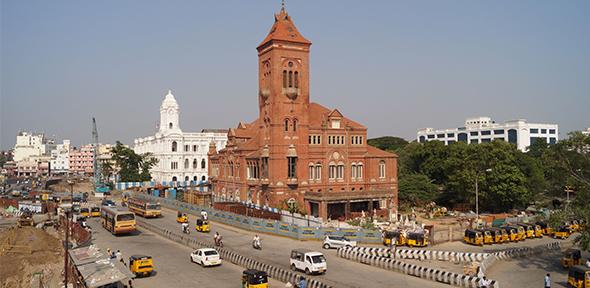Clik here to view.

British Prime Minister Theresa May is visiting India on her first significant overseas visit outside the EU – and there is real interest in how it could be a harbinger of Britain’s post-Brexit future. Analysts are cautious about any major breakthroughs or significant trade deals, especially given strained relations between the UK and India over issues of immigration, which affect students and professionals in particular.
But part of the UK’s agenda is to work bilaterally with India on a number of areas of mutual interest at the UK-India Tech Summit. Discussions will include the technological possibilities for “smart cities”, an area that has been identified by the UK delegation as a major focus for the event. This also resonates with Indian Prime Minister Narendra Modi’s high profile smart cities initiative, launched last year.
Plans focus on making these urban settlements technologically-enabled, to ensure connectivity and communication using the latest information technologies. But what is missing is a sense of how cities may also be “ecologically smart” by securing the essential needs of their inhabitants – particularly clean air, especially important in smog-hit Delhi, and drinking water. It is also important to recognise that “ecological smartness” must include an understanding of the interests, aspirations and current circumstances of the different groups that live in these places.
Clik here to view.

Water wisdom
Over the past three years, a project jointly funded by the UK Department for International Development, the Natural Environment Research Council and the Economic and Social Research Council, has investigated the ways in which people living in and around six small towns in the Western Himalaya access water through a diversity of sources. These range from springs to piped supply, and the project also examined the sustainability challenges faced by these sources.
Through these multiple and far-ranging case studies in Himachal Pradesh, Uttarakhand and Nepal, the team highlighted important lessons relevant to understanding water supply and how it is used and sourced in the urbanising hills. It has also outlined the policy options for securing water supplies for the needs of these hill residents.
Clik here to view.

There are a number of key lessons that emerge from this project, which provide helpful guidance on how to make all cities ecologically, as well as technologically, “smart”. These are:
The importance of critical water zones. The long-term sustainability of water sources is essential for the maintenance and growth of urban settlements. Urban planning and development occurs within city boundaries – but we must also proactively identify, manage and protect the critical water zones – the areas that are essential for the maintenance and regeneration of water flows across all landscapes, and which are often under threat due to rapid urban expansion, encroachment, changes in land use and deforestation.
Inequality and the politics of water distribution. Within towns, cities and surrounding rural settlements, water is highly unequally distributed. Access is determined by a range of historical and socio-economic factors – and negotiations and conflicts around water access, distribution and quality between up- and downstream settlements characterise life in the hills. The diversion and appropriation of water to urban areas could create new conflicts – and we need to understand them.
Local preferences and diverse water strategies. Households in the hills depend on multiple water sources, complementary to piped water connections. This is to do with cultural preferences – such as a belief that spring water in the mountains is sweeter – and risk management, due to the unreliability of municipal supplies. This continued preference for traditional sources alongside technological innovations should inform interventions to improve water availability, especially in small towns.
Clik here to view.

Large infrastructure decisions and management choices. States and donors are increasingly developing top-down, large-investment infrastructure projects to supply water in mountain areas. These so-called “solutions” don’t always consider the full range of possible options – especially those that are more local, small-scale and relevant to those they serve.
Multiple overlapping institutions for water supply. Water supply systems to address the needs of small towns are adopting new and varied governance structures. Donor and state-led systems should engage with local people and institutions both up and downstream, to ensure that development is useful to the communities it affects.
Decision-making and research in the hills often takes place with little access to data, as most of the areas do not have long term monitoring and records. In such contexts, different forms of knowledge are required – these include local wisdom, experience over generations, expert opinion, as well as more innovative approaches to address data gaps (such as modelling). As India and the UK look to each other for areas of mutual dialogue, a focus on ecological smartness might provide a unique opportunity for harnessing the considerable wealth of research on these issues in both countries, as well as responding to the challenges that both India and the UK face as they become increasingly urbanised.
The dialogue around technology involving Britain and India must expand to include the importance of finding ways for living well and sustainably in the rapidly urbanising 21st century.
Bhaskar Vira, Reader in Political Economy at the Department of Geography and Fellow of Fitzwilliam College; Director, University of Cambridge Conservation Research Institute, University of Cambridge and Eszter Kovacs, Postdoctoral Researcher in Conservation, Agriculture and Water Management Policy and Practice, University of Cambridge
This article was originally published on The Conversation. Read the original article.
Bhaskar Vira and Eszter Kovacs (Department of Geography and University of Cambridge Conservation Research Institute) discuss how lessons learned about water management in Nepal and India can guide how cities can be made "ecologically smart".
Image may be NSFW.
Clik here to view.
The text in this work is licensed under a Creative Commons Attribution 4.0 International License. For image use please see separate credits above.